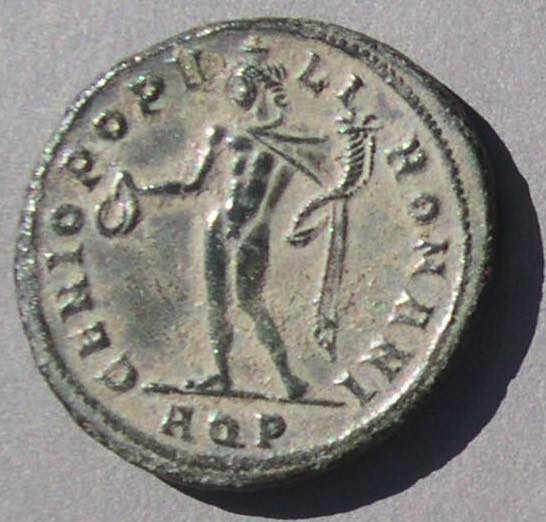
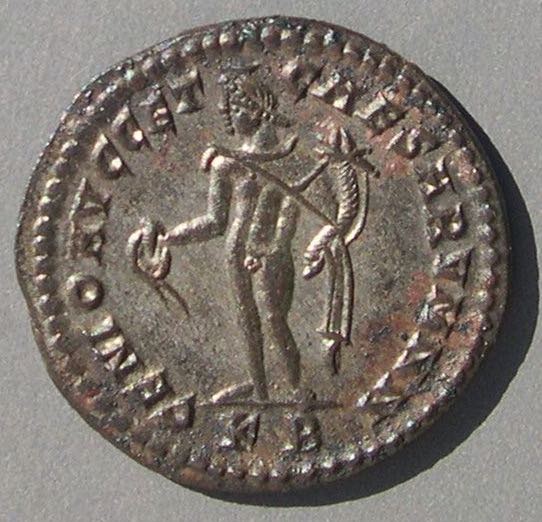

ROMANI
ET CAESARVM NN
Introduced c.294 under the First Tetrarchy.
This coin: 28 mm.
Diocletian at Aquileia.
This coin: 27 mm. Constantius as Caesar at Cyzicus
This coin: 28-26 mm. Constantine as Caesar at Trier.
Genius on Roman coins under the First Tetrarchy and later, 294-315 CE.
"Genius" translates to something like "spirit." Diocletian's coin reform of c. 294 introduced the very common type
GENIO POPVLI ROMANI
"The spirit of the Roman people."
That legend is so common I have given it its own page). The design with Genius standing, holding patera and cornucopia continued in use on the follis denomination with eight new reverse legends until c. 315.
(Click on the images to see both sides of the coin and its description further down this page.)
What's new? 2026, Jan. 4: GENIO IMPERATORIS for Maximianus, third reign.
2023, August 14: GENIO IMPERATORIS, Maximinus II as Augustus at Alexandria.
Contents (links are to sections on this page, further down):
• Introduction, with the seven common reverse legends illustrated.
• The reverse legends listed with links to examples.
• All types illustrated with both sides of each example.
• Design varieties of special interest.
• Additional examples
• Notes on legends and their mints and rulers.
Genius is usually naked but for a chlamys over his left shoulder and draped over his left forearm. However, when Constantius (the western Augustus of the Second Tetrarchy) died and his son Constantine became Caesar, his mints issued for all the rulers with the abbreviated legend GENIO POP ROM and Genius with his loins draped and with boots on his feet (third coin above). The initial legend emphasized the people of Rome, but in the east after 306 the reference to the people was omitted and the rulers and the army were celebrated.
(Click the reverses above to go the coin with both sides illustrated below.)
The rulers with at least one of these types are Diocletian, Maximian, Galerius, Constantius, Severus II (hereafter abbreviated to "Severus"), Maximinus II (hereafter abbreviated to "Maximinus"), Constantine, Licinius, and Maxentius (Among GENIO types Maxentius has only GENIO POP ROM from Lugdunum which is very rare).
Reverse legends. Examples of each are below in order after this list of the nine follis types. Genius appears from western mints only with legends GENIO POPVLI ROMANI and GENIO POP ROM. The other legends were used at eastern mints--never west of Ticinum. The legends on folles include the three at the top of this page:
• GENIO POPVLI ROMANI (below) all mints. (Here are several pages on the folles. Here is a page on all the quarter-follis types.)
• GENIO AVGG ET CAESARVM NN (below) only at Cyzicus (CNG had an unlisted example for Constantius from Nicomedia)
• GENIO POP ROM (below) mints under Constantine, in the west only
The four above from eastern mints:
• GENIO AVGVSTI (here) emphasizing the Augusti, but also issued for the Caesars
• GENIO CAESARIS (here) emphasizing the Caesars, but also issued for the Augusti
• GENIO IMPERATORIS (here) issued for all the current rulers, and
• GENIO EXERCITVS "Spirit of the Army" (here) only at Antioch (issued for all the current rulers).
The two other types are scarce:
• BONO GENIO PII IMPERATORIS (here) only at Alexandria.
• GENIO FIL AVG (here) only for Constantine and only at Antioch.
• Anonymous civic issues under Maximinus II are quite different.
GENIO POPVLI ROMANI has its own pages. There are two denominations with this legend--the follis and the less-common "quarter-follis" only from Siscia.
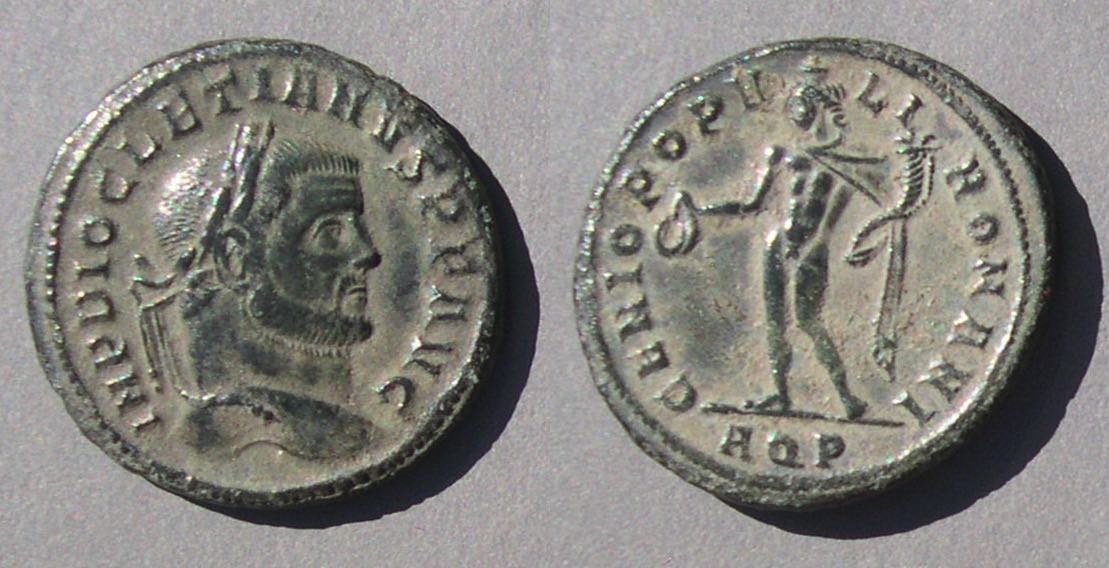
Diocletian
28 mm. 10.15 grams.
IMP DIOCLETIANVS PF AVG
AQP in exergue
RIC Aquileia 23a "c. 296"
This type is very common. This legend has its own pages.
GENIO POPVLI ROMANI, a "quarter-follis", illustrated to scale with the previous follis.
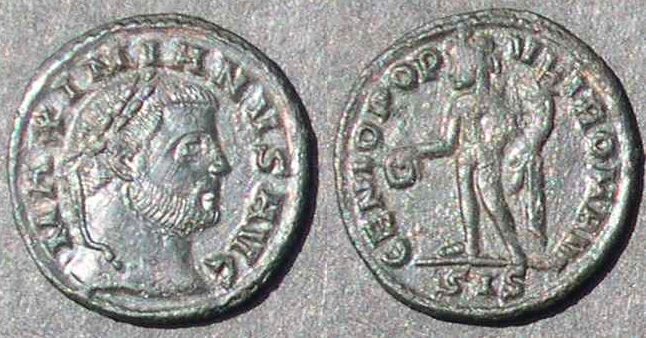 Galerius
Galerius
19 mm. 2.29 grams. Much smaller than a follis. A quarter-follis.
MAXIMIANVS AVG
GENIO POPVLI ROMANI
SIS in exergue
RIC VI Siscia 169b, "305-306." RIC says "R2," but very many have been found since RIC was written.
This denomination was issued only at Siscia and only 305-306. The five rulers named on this denomiantion are the four rulers of the Second Tetrarchy (Constantius, Galerius, Maximinus, and Severus) and Maximian. It has its own page.
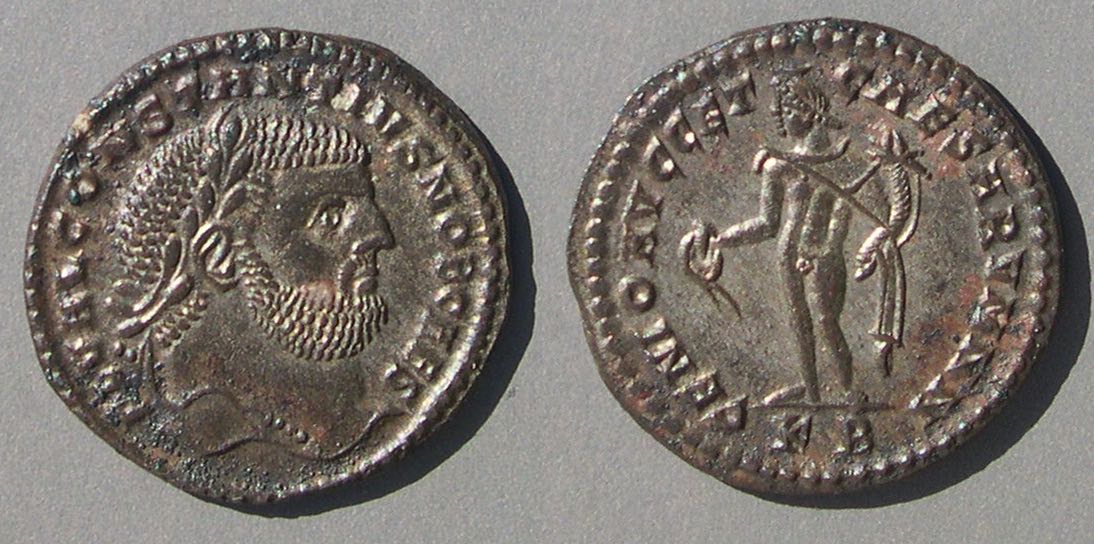
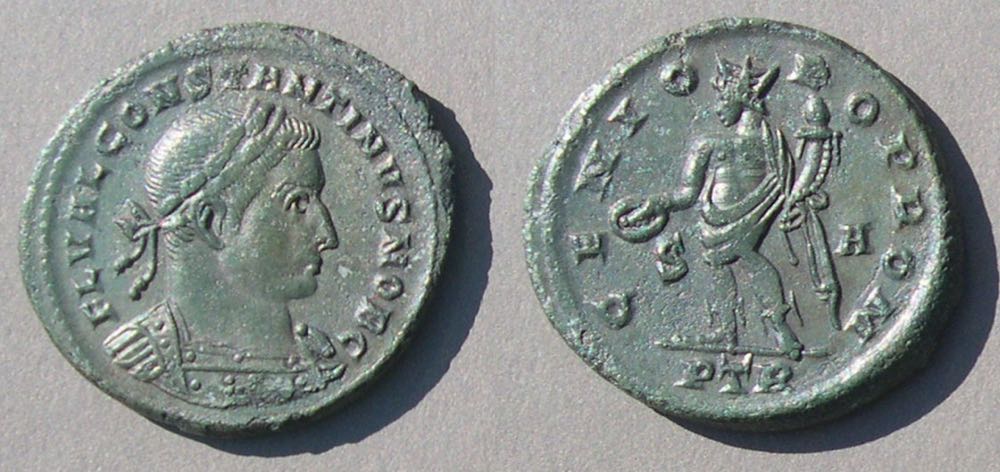
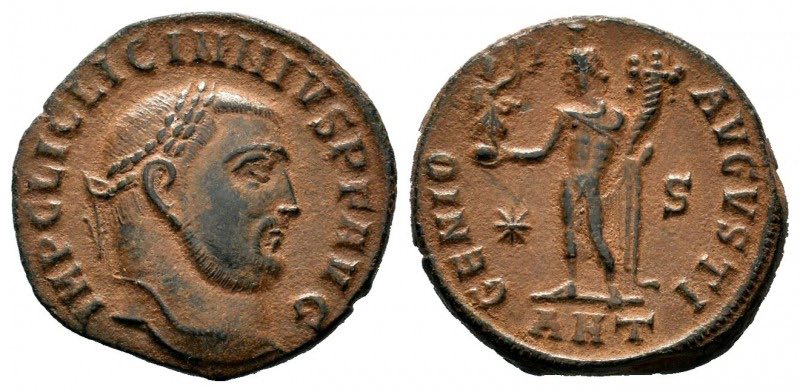
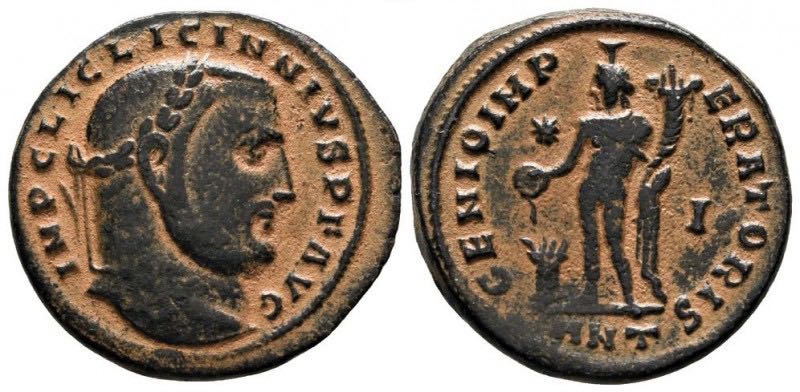
Licinius
24-22 mm. 6.21 grams.
IMP C LIC LICINNIVS PF AVG
(with two N's, which is not the spelling adopted later)
GENIO IMPERATORIS
flaming altar at feet left
✳ I
ANT
RIC VI Antioch 133b
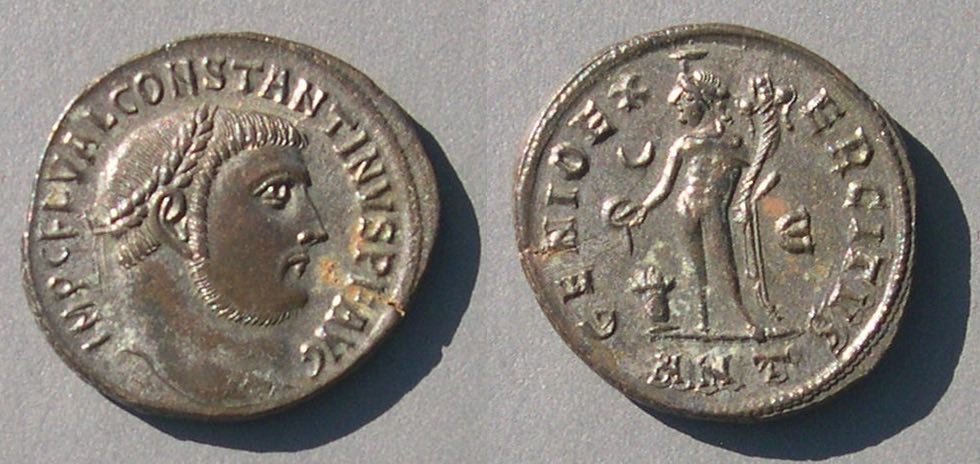
Rarer Types. Two types are much less common.
BONO GENIO PII IMPERATORIS. This legend is scarce because it was used only at Alexandria and only c. 311-312. It was issued for Licinius, Maximinus, and Constantine. The mint of Alexandria belonged to Maximinus and coins with this reverse are almost all in his name.

Maximinus as Augustus
24 mm. 5.97 grams.
IMP C GALER VAL MAXIMINVS PF AVG
BONO GENIO PII IMPERATORIS
<crescent> Γ
K X
ALE
RIC VI Alexandria 144b "c. 311-312."
GENIO FIL AVGG. One more rare Genius legend was issued only at Antioch and only in the name of Constantine:
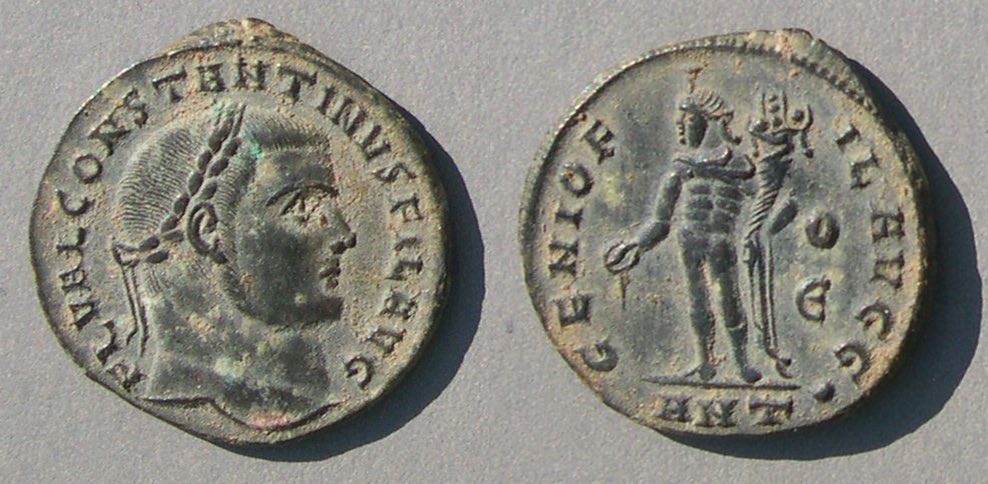
Constantine
24 mm.
FL VAL CONSTANTINVS FIL AVG
GENIO FIL AVGG
O
Є
ANT•
RIC VI Antioch 105 "c. early to later 309".
The title "FIL AVGG" ("son of the Augusti") was awarded to Constantine and Maximinus by Galerius and may explain the use of GENIO IMPERATORIS at mints of Galerius. Because Galerius did not regard them as either Caesars or Augusti, rather with this intermediate rank, the legend with IMPERATORIS could include all the current rulers in one legend. This coin has obverse title FIL AVG, not Augustus or Caesar. For much more about the episode when Galerius awarded the title "FIL AVGG" to Constantine and Maximian, see the page on FIL AVGG coins.
Anonymous civic issues under Maximinus II (AD 310-313). Civic issues, sometimes called "pagan" issues, are quite different and have their own page. Two have legends including the word "GENIO". The coins are much smaller than the previous folles.
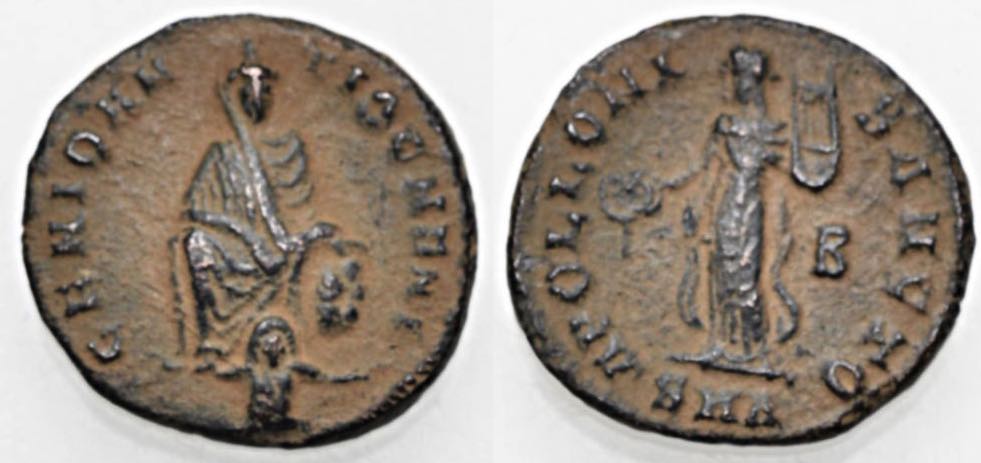 16-15 mm. End of 311 to December 312, under Maximinus
16-15 mm. End of 311 to December 312, under Maximinus
GENIO AN-TIOCNENI, Antioch seated facing, river god swimming below
APOLLONI-SANCTO, Apollo holding patera and lyre
B
SMA in exergue (Sacra Moneta Antioch).
Vagi 2954. van Heesch, type 3, plate 11.3. (96 examples) [All photos are the same scale.]
Not in RIC, but common anyway.
van Heesch (1975) was able to use the mintmarks and especially the large number of active officina (11 officina from A to IA) to show that the whole series was from the time of the persecutions of Christians under Maximinus (May 310 to July 311), not Julian II (360-363). In his 1993 article he revised the date to between the end of 311 and December 312, a period of renewed persecutions of Christians.
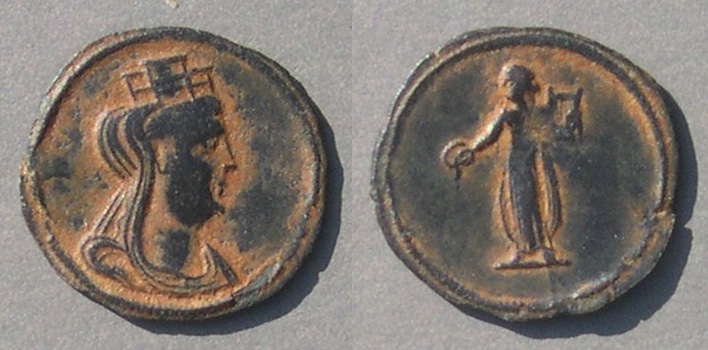 17 mm.
17 mm.
No legend, either side, but there is a type precisely like it (I don't have one to show) except with legends:
GENIO CIVITATVS/APOLLOINI SANCTO, which confirms the mint is Antioch.
Veiled and turreted head of Tyche right
Apollo standing left holding patera and lyre.
Vagi 2957. van Heesch type 5, plate 11.8 (2 examples)
[This type without legend was first published--as unique--in August 1986 in the sale catalog Elsen 91, lot 366.]
The type with legends on both sides is Vagi 2956 and van Heesch type 4, plate 11.4.
Design Varieties. Not counting mint marks and control marks, there are some design varieties of special interest.
• Altar at feet (above)
• Genius holds Victory (above)
• Genius holds head of Serapis
• Genius holds head of Sol
• Eagle at feet
• Issued for the ruler as FIL AVGG
• Legend extended with  CMH(?)
CMH(?)
GENIO POPVLI ROMANI, Genius holds head of Serapis
 Constantine.
Constantine.
21 mm. 6.03 grams.
FL VALER CONSTANTINVS PF AVG
GENIO POPVLI ROMANI
(At this late date this legend is unusual. Most GENIO POPVLI ROMANI coins are much earlier.)
Genius holds head of Serapis
II Δ
<palm> R
ALE
RIC VII Alexandria 4 "313-314"
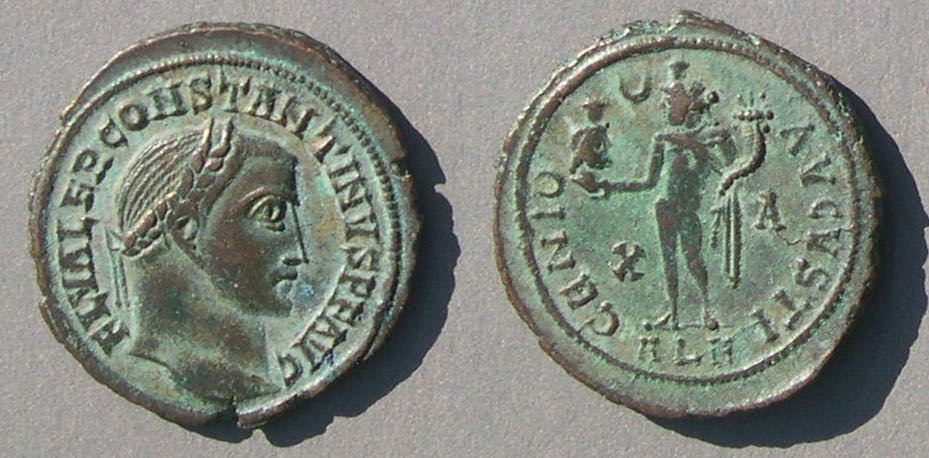 Constantine
Constantine
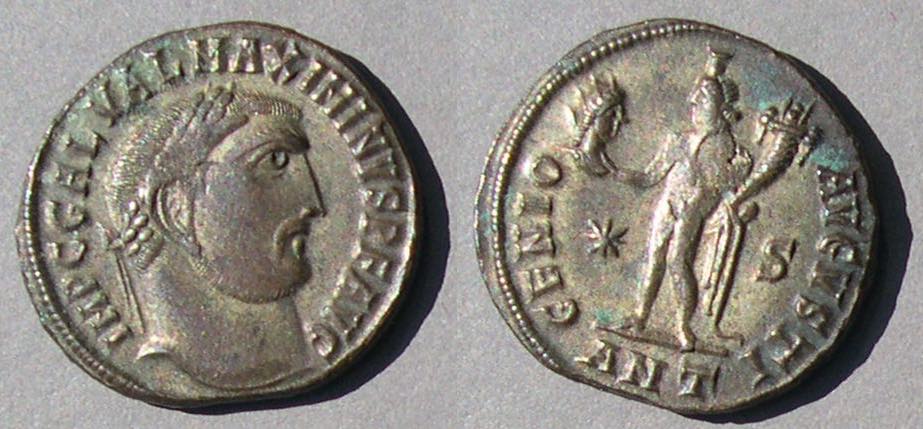
Maximinus II
21 mm. 4.54 grams.
IMP C GAL VAL MAXIMINVS PF AVG
Genius holds head of Sol.
✳ S
ANT
RIC VI Antioch 164b "312"
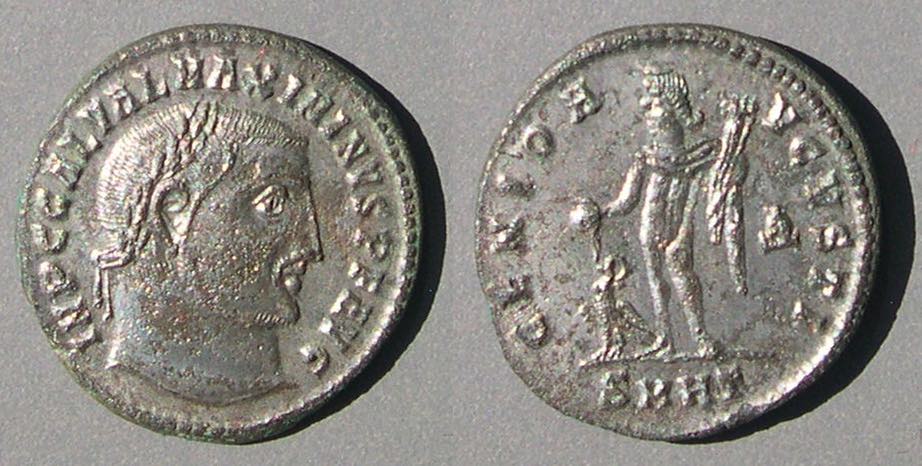 Maximinus II
Maximinus IIGENIO CAESARIS with FIL AVGG title. Among all the Roman rulers only Constantine and Maximinus ever had coins with the title FIL AVGG.
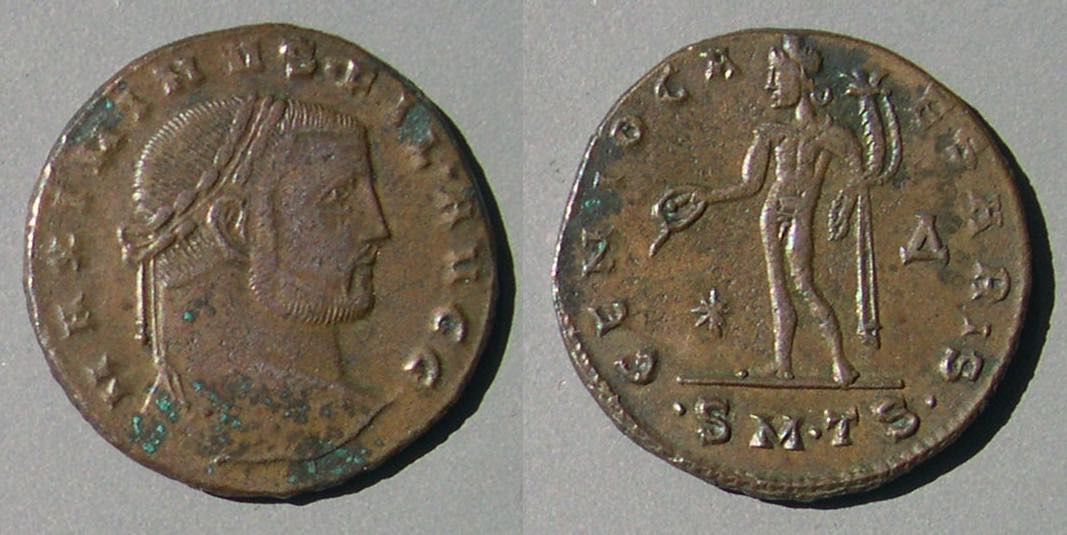
Maximinus II
MAXIMINVS•FIL•AVGG
GENIO CAESARIS
✳ Δ
•SM•TS•
RIC VI Thessalonica 32a "308"
For much more about about the period when the FIL AVGG title was used, see the page "Constantine as Caesar and FIL AVG."
 The legend GENIO AVGVSTI is extended with this monogram, which most authors say is "CMH", at Nicomedia and Cycius. The legend GENIO CAESARIS is extended with CMH at Nicomedia.
The legend GENIO AVGVSTI is extended with this monogram, which most authors say is "CMH", at Nicomedia and Cycius. The legend GENIO CAESARIS is extended with CMH at Nicomedia. 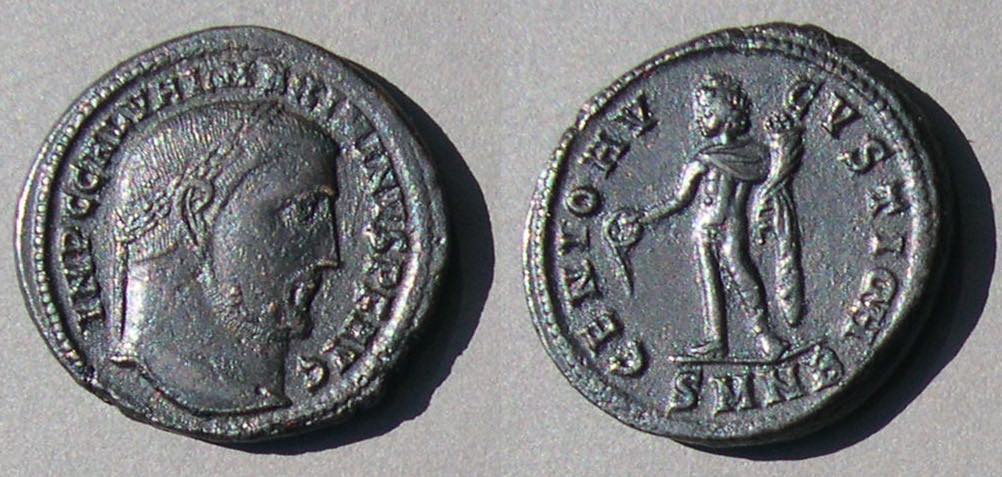 Maximinus II
Maximinus II .
.Additional Examples.
GENIO AVGG ET CAESARVM NN. This type was issued only for the Caesars and only at Cyzicus. It began during the First Tetrarchy (for Constantius, above, and Galerius, next) and continued for the Caesars of the Second Tetrarchy (Severus II and Maximinus II) and after the Second Tetrarchy (Constantine).
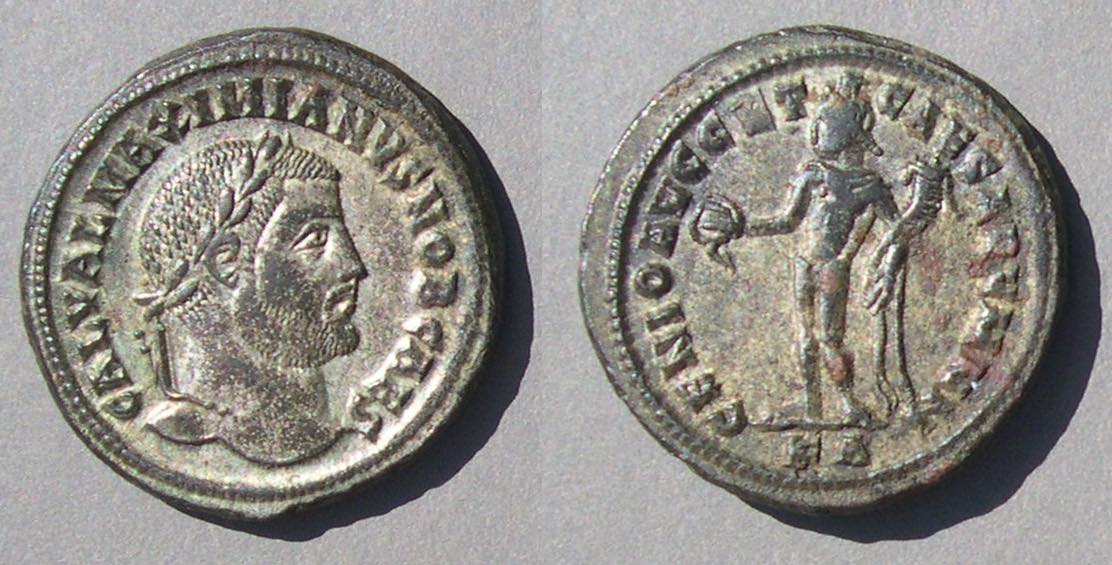
Galerius as Caesar, 293-305, during the First Tetrarchy.
28 mm. 11.97 grams.
GENIO AVGG ET CAESARVM NN
KA
RIC VI Cyzicus 9b "c. 295-6"
Severus II became the western Caesar, upon the retirements of Maximian and Diocletian.
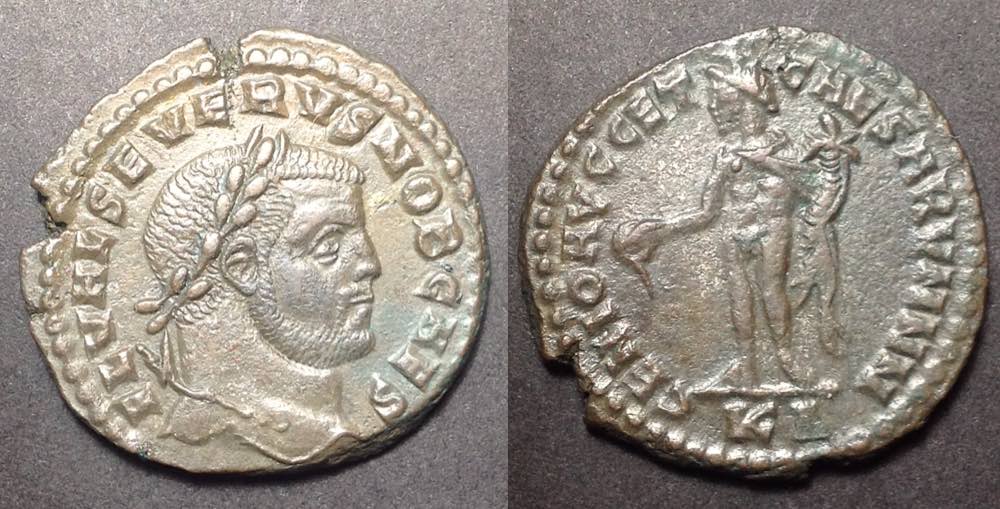
Severus as Caesar, 305-306, during the Second Tetrarchy.
27-26 mm. 9.32 grams.
GENIO AVGG ET CAESARVM NN
KΔ
RIC VI Cyzicus 20a "305-306" i.e. during the Second Tetrarchy.
Maximinus II as Caesar, 305-306,
27 mm. 9.08 grams.
GENIO AVGG ET CAESARVM NN
*
KΔ
RIC VI Cyzicus 26a "c. 307, early," i.e. just after the Second Tetrarchy (Constantine in in this issue).
Failmezger 45
 Constantine as Caesar, July 25, 306 to July 25, 307.
Constantine as Caesar, July 25, 306 to July 25, 307. Maximinus II
Maximinus II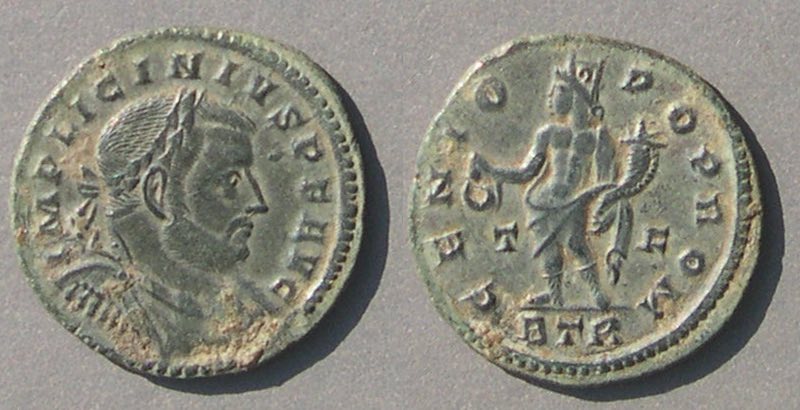 Licinius
Licinius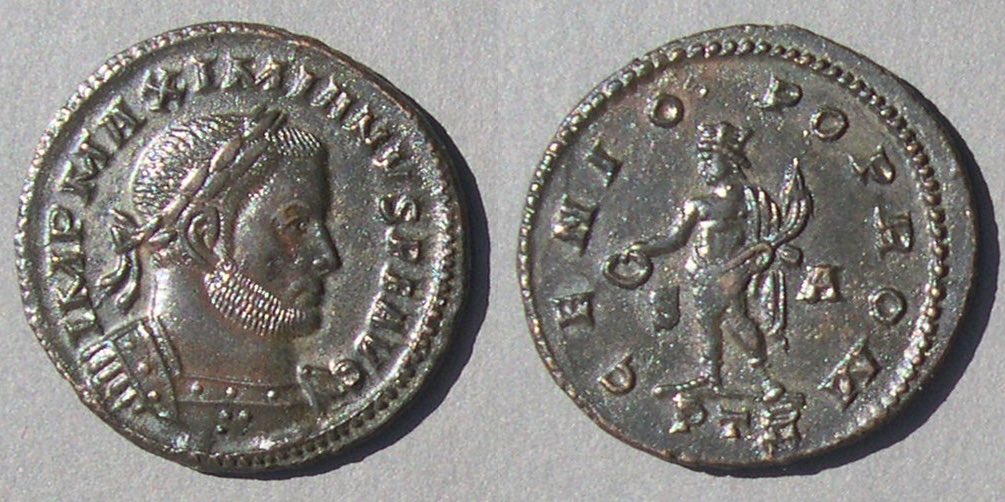 Galerius
Galerius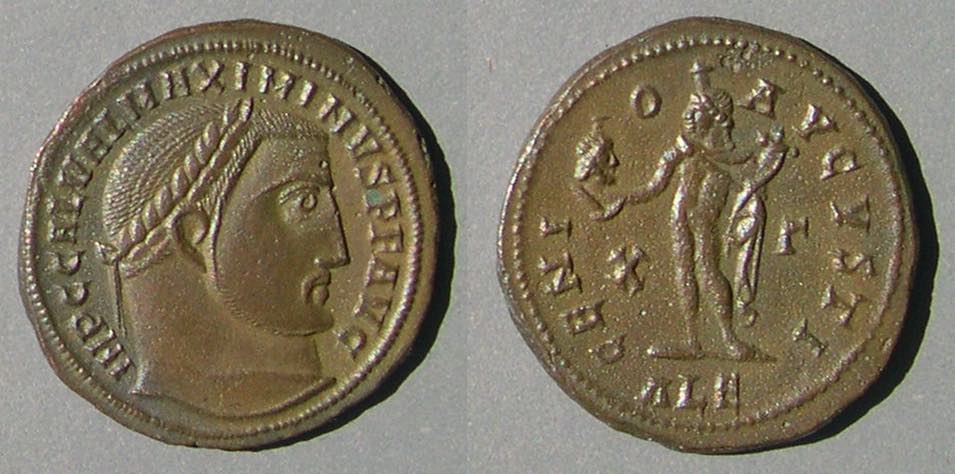 Maximinus II
Maximinus IIMaximinus II, as Invictus Augustus
25 mm. 7.15 grams.
IMP C GAL VAL MAXIMINVS PF INV AVG
GENIO IMPERATORIS
* crescent
HTΔ
RIC VI Heraclea 61, "c. 311"
Heraclea was a mint of Galerius. After Carnuntum he recognized Licinius as Augustus, Maximinus as Caesar, and Constantine was ignored. Maximinus remained Caesar until c. May 310, at which time Galerius finally relented and recognized both Constantine and Maximinus II as Augusti. There were then, at that mint, four Augusti and no Caesars.
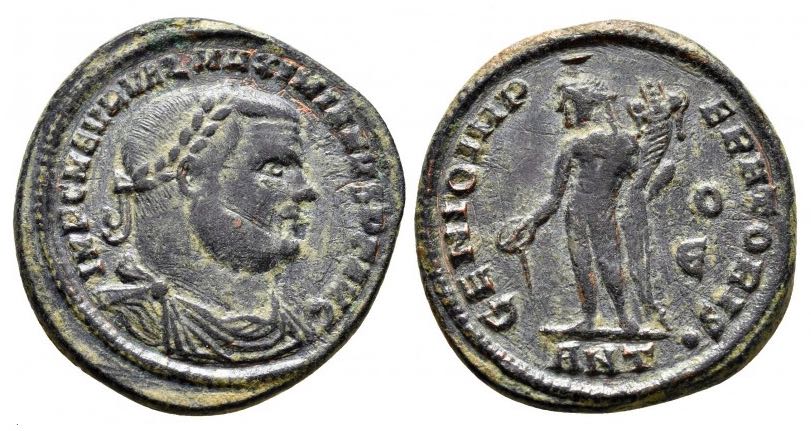 Maximian, third reign!
Maximian, third reign!
25-24 mm. 7.21 grams.
308-31
IMP C M AVR VAL MAXIMIANVS PF AVG
(A legend for an active Augustus)
GENIO IMPERATORIS
O
Є
ANT •
RIC VI Antioch 112c "early to later 309"
How can we know this type was issued during his third reign? We know because Licinius was included in the issue, and the definition of his "third reign" is the time after the Conference at Carnuntum when Licinius was made Augustus.
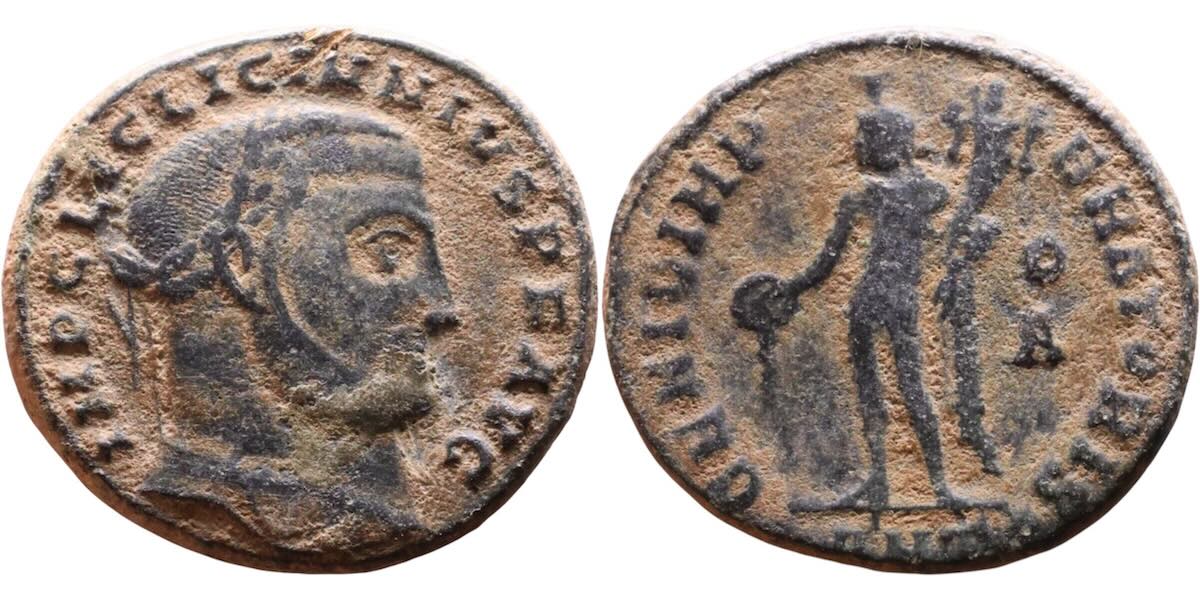 Licinius, 308-324
Licinius, 308-324Notes.
GENIO POPVLI ROMANI has its own follis page and its own page for quarter-folles. Mostly discontinued c. 307, but it was revived twice--once at Rome for Constantine, Maximinus, and Licinius, as Augusti, after the Battle at the Milvian Bridge in late 312 and a second time in a reduced module at Alexandria for Licinius and Constantine after the death of Maximinus in 313.
GENIO AVGG ET CAESARVM NN. Issued only at Cyzicus and only for Caesars. Under the First Tetrarchy it was issued in the names of Constantius and Galerius as Caesars. Under the Second Tetrarchy it was issued in the names of Maximinus and Severus as Caesars, and later in the name of Constantine as Caesar.
GENIO POP ROM. c. 307 Constantine's mints replaced GENIO POPVLI ROMANI with this shorter legend and replaced the naked Genius with Genius depicted with loins draped and boots. Some mints discontinued GENIO POPVLI ROMANI earlier. For example, Rome changed its main type to SACRA MONETA c. 301 to accompany the Edict on Maximium Prices. GENIO POP ROM was issued at London, Trier, and Lyons (and Ostia after the Battle of the Milvian Bridge). The type continued as late as 316 [RIC] or 315 [Schulten] for Constantine as Caesar and as Augustus, Licinius as Augustus (he was never just Caesar), Maximian as Augustus and as Senior Augustus, Galerius as Augustus, Maximinus as Caesar and as Augustus at Ostia.
After the death of Galerius in 311 the "Genius types were principally a characteristic of mints controlled by Maximinus." [RIC VI, p. 53]
GENIO AVGVSTI. Late 307 -312 for Galerius as Augustus, Licinius as Augustus, Constantine as Augustus and as FIL AVGG, Maximinus as Caesar and as FIL AVGG. Eight eastern mints. Legend extended by CMH monogram for Galerius as Augustus, Licinius, Maximinus as Augustus, and Constantine as Augustus.
GENIO CAESARIS. c. Spring 307 - 311 for Galerius as Augustus, Licinius, Constantine as Caesar as Augustus and as FIL AVG, Maximinus as Caesar and as FIL AVGG and as Augustus. Eight eastern mints.
GENIO IMPERATORIS. c. Spring 307 - 310 for Galerius as Augustus, Licinius, Maximinus as Caesar and as Augustus, Constantine as Augustus and as FIL AVG. For eastern mints.
GENIO EXERCITVS. Only c. 310-311 only at Antioch. For Galerius as Augustus, Licinius, Maximinus as Caesar, and Constantine as Augustus.
BONO GENIO PII IMPERATORIS. Only at Alexandria and only c. 311-312, for Licinius, Maximinus, and Constantine, all as Augusti. One example for Maximinus II as Caesar, not in RIC, was on Victor's Imperial Coins vcoins site in March 2020.
GENIO FIL AVGG. Only for Constantine as FIL AVGG, only at Antioch. For more see the long page on FIL AVG coins.
References.
RIC VI. Roman Imperial Coinage, Volume VI, From Diocletian's reform (A.D. 294) to the death of Maximinus (A.D. 313), by C. H. V. Sutherland. 1973. Many varieties have been discovered since this book was published, but there is no easy way know more than is in this book. Many collectors use RIC solely to provide identification numbers, but it has far more interesting information than just that, including lots of history and chronology with relevant coin evidence.
RIC VII. Roman Imperial Coinage, Volume VII, Constantine and Licinius, A.D. 313-337, by Patrick M. Bruun. 1966. This book begins after the deaths of the eastern rulers Galerius and Maximinus. Only Constantine and Licinius remain. Few Genius types are issued this late. They are: GENIO POP ROM for Licinius and Constantine at London and Arles, and for Licinius at Lyon and Trier (Constantine was using SOLI INVICTO COMITI); GENIO AVGVSTI CMH for Licinius and Constantine at Cyzicus 313-315; GENIO POPVLI ROMANI for Licinius and Constantine at Alexandria 313-314; a reduced-size GENIO POPVLI ROMANI for Constantine and Licinius at Alexandria.
Failmezger, Victory "Tory." Roman Bronze Coins from Paganism to Christianity, 294-364 A.D. A complete list of types (but not mints, varieties, and RIC numbers) from the coin reform to 364, with very many color photos and short outlines of the history, with chapters on collectible types like the "fallen horseman" coins of the coin reform of 348. I love this book and use it to keep track of types.
Schulten, Peter J. Die Römische Münzstätte Trier. 1974. Paperback. 52 pages and ten plates.
Vagi, David. Coinage and History of the Roman Empire. 1999. Two volumes.
van Heesch, Johan. "The last civic coinages and the religious policy of Maximinus Daza, A.D. 312," Numismatic Chronicle, 153, 1993, p. 65-76.
The end
Go to the main Table of Contents page of this whole educational site.
Go to a page of links to other pages on coins of the tetrarchies.
Go to the page "Introduction to Roman coins of the First Tetrarchy."